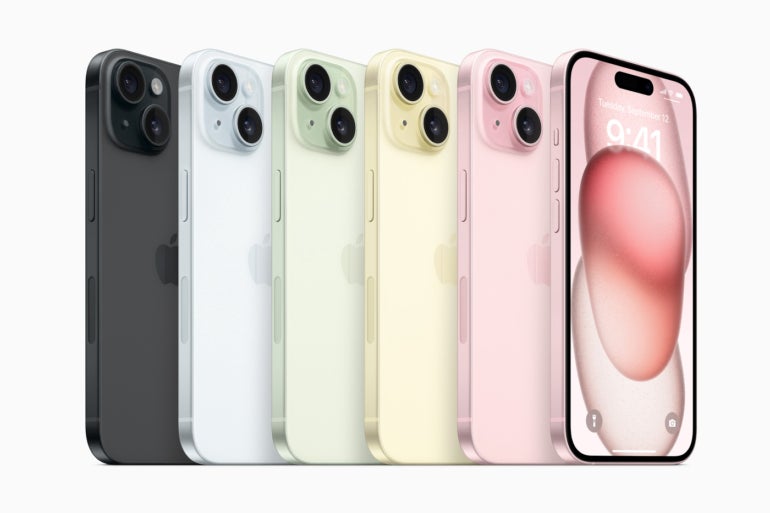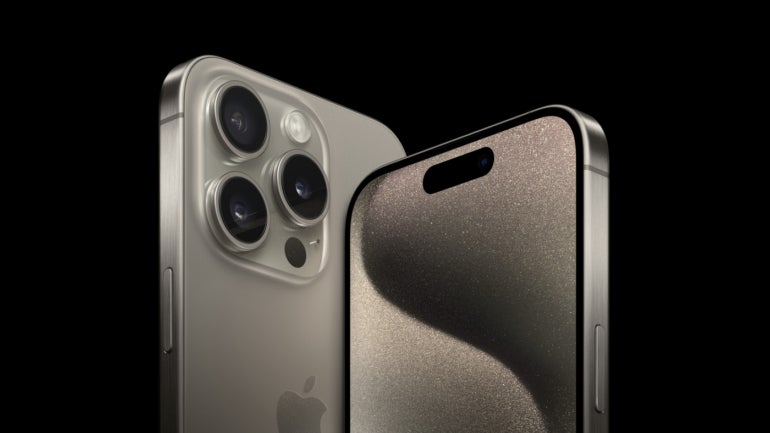Apple’s September 2023 Wonderlust Event introduced the iPhone 15, and now you might be wondering if you should buy one of these new models or an iPhone 14. Other questions might include, “Should I buy the iPhone 15 or iPhone 15 Pro?” or “Should I buy the iPhone 15 Plus or iPhone 15 Pro Max?”
Don’t let confusion lead to buying the wrong iPhone 15 or iPhone 15 Pro model or configuration. And by making a buying error, I don’t mean choosing a color (Figure A) you later regret or worrying about wasting money purchasing AppleCare+; the protective case you buy will likely obscure the color, and I recommend pairing AppleCare+ whenever purchasing a mobile Apple device. I’m referring to avoiding three bigger buying mistakes that can’t easily be rectified when purchasing a new iPhone 15 or iPhone 15 Pro.
Figure A:

Jump to:
1. Selecting the wrong iPhone 15 model
New iPhone 15 prices range from $799 for 6.1-inch 128 GB iPhone 15 models to $1,599 for 6.7-inch 1 TB iPhone 15 Pro Max devices. Purchasing an iPhone 15 Pro when all you need is an iPhone 15 can cost you hundreds of wasted dollars. Conversely, purchasing an iPhone 15 when you actually need features available in an iPhone 15 Pro (e.g., transferring data at USB 3 speeds that are up to 20 times faster than the iPhone 15’s USB 2 standard) could cost you even more in lost opportunities and productivity.
While the regular and Pro models are capable devices with impressive overall performance and displays, only the iPhone 15 Pro offers ProMotion and adaptive refresh rates up to 120 Hz. The iPhone 15 Pro versions also offer macro photography and spatial video capabilities, Apple ProRaw support, log video recording and the Academy Color Encoding System compatibility. These are all important considerations for professionals using Apple devices for graphic art, advertising, marketing, communications and other video production responsibilities.
When selecting an iPhone 15 model, carefully consider your needs. If you know why the spatial video feature, ACES standard and ProRaw benefits are important. Additionally, if your professional responsibilities require these Pro model features and capabilities, you likely need the Pro model featuring the more advanced camera (Figure B). Otherwise, you may be better served by saving money and choosing the highly capable standard iPhone 15 version instead.
Figure B:

2. Choosing the wrong size for your iPhone 15
Here is the size for each iPhone 15.
- iPhone 15 is 5.81 inches tall by 2.82 inches wide, just 0.31 inches thick and features a 6.1-inch screen.
- iPhone 15 Plus is 6.33 inches tall by 3.06 inches wide, just 0.31 inches thick and features a 6.7-inch screen.
- iPhone 15 Pro is 5.77 inches tall by 2.78 inches wide, just 0.32 inches thick and features a 6.1-inch screen.
- iPhone 15 Pro Max is 6.29 inches tall by 3.02 inches wide, just 0.32 inches thick and features a 6.7-inch screen.
Both the larger iPhone 15 Plus and iPhone 15 Pro Max feature high-quality 6.7-inch Super Retina XDR displays. Because the Plus and Pro Max models offer approximately 20% larger screens and have bigger batteries, offering longer operation (up to 29 hours for the iPhone 15 Pro Max and 26 hours for the iPhone 15 Plus vs. 20 hours for the standard iPhone 15 and the iPhone 15 Pro’s 23 hours), it’s tempting to believe the larger size phones are better. But the bigger the phone, the less portable the device becomes.
Before opting for a larger size, consider how often you place and remove an iPhone from your pocket. Weigh how often you travel and stuff the smartphone in a backpack or purse. Also factor in how frequently you squeeze the device between a shift lever to place it on an in-car charging pad or within a dedicated storage pocket in your vehicle. In many cases, the larger Plus and Max models don’t fit in all of these instances.
Playing devil’s advocate, a larger screen displays more information. Larger displays are also easier to read. So it’s a tradeoff, but one to be considered carefully. If you’re unsure which size might work best for you, try marking the actual size of the iPhone 15’s you’re considering purchasing on a piece of paper and cutting each out, then placing them side-by-side on a desk to gain a better feel for the device’s size. Or, if possible, visit an Apple Store when the units become available on September 22.
3. Buying the wrong storage capacity for your iPhone 15
Here is a quick list of the storage capacities Apple is offering with each iPhone 15 model.
- iPhone 15 is available in 128 GB, 256 GB and 512 GB versions.
- iPhone 15 Plus is available in 128 GB, 256 GB and 512 GB models.
- iPhone 15 Pro is available in 128 GB, 256 GB, 512 GB and 1 TB versions.
- iPhone 15 Pro Max is available in 256 GB, 512 GB and 1 TB versions.
Determining how much storage you need when buying a new iPhone 15 is likely easier than you think. But before selecting the proper choice for you, it might be helpful to perform a quick calculation to confirm how much space apps and data on your current phone are consuming. The calculation is particularly important because the answer can help you correctly select the proper capacity when purchasing a new iPhone 15, as adding more storage is unrealistic.
While it’s tempting to believe it’s best to purchase much more capacity than you need or even the minimum capacity to save money, storage is among the primary factors impacting cost. Subsequently, buying more capacity than you will ever use can be an expensive mistake.
Fortunately, Apple’s done well by enabling the storage of high-resolution images and videos in iCloud, thereby reducing local storage requirements. Thus, the storage space needed is sometimes less for professionals than they might initially believe.
I recommend reviewing how much storage you’re actively using on your existing iPhone or smartphone if you’re migrating to an iPhone. Within iOS, to determine how much storage you’re consuming, tap Settings, select General, then tap About. Scroll down to read the Capacity and Available values. Subtracting Available space from the smartphone’s Capacity reveals how much storage you’re actively using. Make a note of that number.
When calculating the storage capacity you require, don’t forget to include the space iOS itself needs. The amount of storage iOS and corresponding system software require varies, but for comparison sake, iOS 16.6 consumes approximately 10 GB on my iPhone 14 Pro.
You should ensure your new iPhone 15 model has sufficient capacity to accommodate both: the amount of space you’re currently using that you noted earlier, plus 10GB or so for iOS itself and another 40 to 50% or so free space to accommodate future use. So the total storage required equals the space iOS requires, the amount of space you’re currently using and additional space to accommodate future use.
While you can make adjustments — such as removing unneeded apps, adjusting image settings to leave larger files in the cloud and deleting files from your phone that are no longer needed — only you can decide whether taking such steps is appropriate and will reasonably accommodate how you really work. For example, if you need high-resolution images and numerous apps on your phone, it’s unrealistic to assume you can free up space by eliminating those elements. Remember, too, that you should reserve at least 15% or so of your storage for new mail, attachments, messages, apps and data, as well as to accommodate software updates and general operation.
Specs, pricing, features for iPhone 15 models
The devices feature Apple’s capable A16 chip and new 48MP cameras, while iPhone 15 Pro devices introduce the new and even more potent A17 Pro processors and additional camera upgrades such as macro photography, Apple ProRaw photo-editing and ProRes video recording capabilities. Apple’s presentation during the Sept. 2023 event confirmed that iPhone 15 and iPhone 15 Pro devices include the more widely used USB-C ports instead of the proprietary Lightning ports long-associated with Apple iPhones.
Other iPhone 15 and iPhone 15 Pro features include next-generation portraits with enhanced focus and depth control, optical zoom up to 3x with Pro models, improved peak brightness, all-day battery life, satellite-powered roadside assistance and 4K video recording up to 60 fps.
For more in-depth information about specs and features, read our iPhone 15 cheat sheet.
Source of Article



